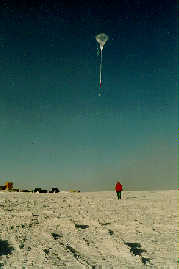| |
The ozonesonde is a lightweight,
balloon-borne instrument that is mated to a conventional meteorological
radiosonde. As the balloon carrying the instrument package ascends
through the atmosphere, the ozonesonde telemeters to a ground
receiving station information on ozone and standard meteorological
quantities such as pressure, temperature and humidity. The balloon
will ascend to altitudes of about 115,000 feet (35 km) or about
4 hPa before it bursts. The heart of the ozonesonde is an electrochemical
concentration cell (ECC) that senses ozone as is reacts with
a dilute solution of potassium iodide to produce a weak electrical
current proportional to the ozone concentration of the sampled
air.
|
|
 |
|
| |
The CMDL network of eight ozonesonde sites makes weekly ozone
vertical profile observations from the surface to about 35 km
using electrochemical concentration cell (ECC) ozonesondes.
Three of these sites, Boulder, Colorado, Hilo, Hawaii, and South
Pole, Antarctica have records of at least 15 years in length
covering a significant portion of the period that stratospheric
ozone has been declining. There are about 50 locations around
the world that make regular (approximately weekly) ozone vertical
profile measurements using ozonesondes.
For additional information on the ECC ozonesonde
as well as data from the CMDL sites visit the CMDL
website.
|
|

